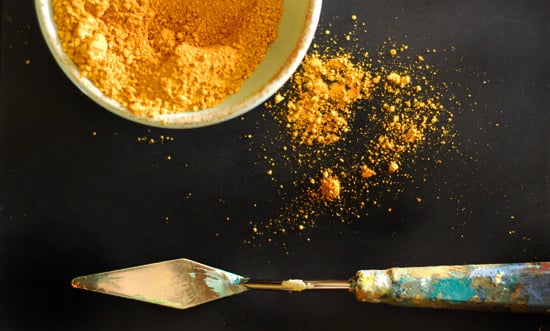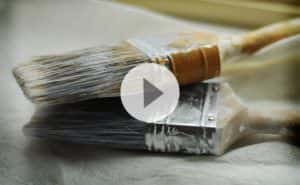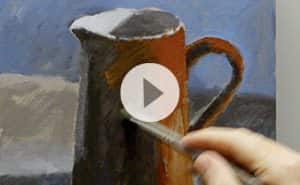
From Oil to Egg Yolks
Same pigment, different binder.
In a nutshell, most paints are made by mixing dry paint pigment together with a wet binder.
The difference between the type of paints, such as oil paint, acrylic paint or watercolour, is simply due to the different binder type used.
So the binder could be oil, acrylic polymer or even egg yolk, and it’s this – that gives each painting its characteristics…
Pigments
Pigments traditionally started out as earth or rocks. Some of the oldest pigments are made from coloured earth, like yellow ochre and are called earth colours; they tend to be muted in colour. Different oil colours have been created as new pigments, and manufacturing methods have been developed. These modern pigments are brighter and man-made.
Pigments can be divided into three camps:
Inorganic Pigments – Rocks, minerals or metal.
Organic Pigments – Substances that were once part of a living thing, plants, bone or synthetic treatment of plant stuff.
Artificial Pigments – These are often derived from organic pigments that have been chemically altered. They can make a more stable and consistent paint.
A Word of Warning about Artificial Pigments
For those starting painting, I wouldn’t recommend using all man-made pigments as they can ruin a painting more quickly than help it. I always adhere to starting with the dullest, most natural colours and creeping up on the stronger, brighter colours.
This helps you to think more tonally and will pay dividends in the long run. Think small steps.
Here’s a quick guide on how to choose a starter paint set and a free tutorial using only two colours.
What are Oil Paints?
Oil paints are made from dry pigments ground together with oil. Most commonly, cold-pressed linseed oil.
Oil paint’s odour depends on the oil used: If the paint is ground in linseed oil, it will smell of linseed oil.
- If the paint is ground in linseed oil, it will smell of linseed oil.
- If the paint is ground in walnut oil, it will smell of walnut oil.
- If the paint is ground in poppy oil, it will smell of poppy oil.
How do Oil paints dry?
Oil paints dry by oxidation (when the paint has contact with the air)
It’s not the pigment that takes the time to dry, but the oil. Because oil is slow drying, oil paints have a long ‘working time’.
When the oil oxidizes, it forms a solid film that binds the dry pigments together, like baking a cake; the mixture starts smooth, gets ‘cooked’ in the air and dries.
Oil paint can take anywhere between 6 months and a year to fully dry, depending on the thickness of the paint used.
What are Acrylic paints?
Acrylic paints consist of a pigment suspended in a binder of an acrylic polymer emulsion.
How do Acrylic paints dry?
As water is the vehicle for the acrylic polymer emulsion, acrylic paint’s dry by evaporation.
Because water evaporates quickly, acrylics are fast-drying, so have a short ‘working time’ (this can vary slightly, depending on the heat and humidity of the environment you’re painting in)
So, which paint will suit you best?
Have a look at the 5 key differences between oils and acrylic paint.
What is Watercolour?
Watercolour paints are pigments held together by a water-soluble binder, along with additives and solvents.
In commercially made watercolor paints, the binder is either natural gum Arabic or synthetic glycol. This is what holds the pigment in suspension. The binder also allows the pigment to adhere to the support (e.g. paper) once it is applied. Additives, such as plasticisers (e.g. glycerin) and humectants (e.g. honey or corn syrup), are mixed in to alter the watercolours’ various characteristics, such as the viscosity and durability of the paint. Other additives include extenders and dispersants.
How do Watercolour paints dry?
By evaporation.
However, due to watercolours’ nature and application, you’re usually using a lot of water and a support that holds water, so the working time is more than acrylics.
What is Egg Tempera?
Egg tempera is made up of egg yolk, powdered pigment, and distilled water. The egg yolk serves as the binder that holds the pigment together. The addition of water turns the paint into a usable paste-like form. Manufactured egg tempera also includes gums that act as dispersants are like salt, grainy particles that can be milled and crushed to make smaller and smoother.
Pro Tip: To test the quality of a dry pigment, place a small amount in a glass jar, add water, give it a stir and leave for a few days. The solid particles of the dry pigment should float down to the bottom, leaving the water clear. If it’s not clear, some form of dye has been added to enhance the colour.
What are Pastels?
Pastels are usually in stick form, similar to chalk.
A pastel stick consists of pure powdered pigment and a binder, such as gum Arabic, gum tragacanth, or methylcellulose. Pastels have a higher pigment concentration than any other artist medium (hence the rich, luminous colors that pastels can achieve). The powdered pigments used in pastels are similar to those found in oil paints.
Pastels can be hard or soft. Soft pastels have more pigment and less binder, so they are easier to smudge and have brighter colours. Hard pastels have less pigment and more binder than soft pastels. Hard pastels can stay relatively sharp, so they are ideal for pastel artwork that requires tight detail.
Some Pigment Colour Pointers:
There are some confusing aspects to the names of pigments; keep these points in mind:
Similar pigments are sold under different trade names.
For example, Winsor & Newton’s Winsor Blue and Liquitex’s Phthalo Blue are both based on the same pigment: Phthalocyanine Blue.
Don’t get confused by Hue
The labeling on paints can be really confusing.
‘Hue’ in colour mixing land just means the colour of paint, i.e. that yellow has an orangey hue to it.
However, in paint labelling, ‘Hue‘ means ‘fake’ or ‘imitation’. So a label that says:
Cadmium Red Hue means that this isn’t a pure pigment made from Cadmium Red. Some of it might be Cadmium Red, but it has been mixed with something else to give it a similar colour. This used to be a sign of inferior quality paints, but now it’s because some natural pigments are no longer available, not as lightfast or extremely costly. You can read about the 8 key differences between student & artist-grade paints here.





“Indian yellow used to be produced by feeding cows mango leaves and using the colour produced in the urine to make the paint pigment!! The practice was outlawed in 1908 due to malnutrition of the cows”
Wide spread myth.
Cows like mango leaves!
“the coloring matter is extracted from a tree, or large shrub, called memecylon tinctorium*” David Myers
Hi John,
Oh, what a shame! I used to love telling the kids the paint we where using used to be made from cows urine, you should have seen their faces! Thanks for the note.
Will.
great evening at Formby artists demo, Many thanks.
Oh Hi Annette, thanks for dropping by, so pleased you enjoyed the demo.
Cheers,
Will
I want to learn the door paint mixer along the paints, and the mixer by write the iron boards with paint adding chemical name and information. This is requesting. Kamma Babu. Chennai. 11-11-2013.
Hi Kamma, I’m not exactly sure what you’re trying to mix?
Which support is best for egg tempera paintings? will egg tempera paintings will dry faster as acrylic? will it long last for ages like oils?
Hi Vishnu, you might find this article (and website) helpful on egg tempera techniques & supports
Cheers,
Will
thanks will!!! great guidance!!!
Hi,
I want to conduct an experiment that will demonstrate how different kinds of white paint reflect off different wavelengths of light (different colors) at varying intensities. Could you guide me as to what kinds of white paints there is? Are there different pigments used for different white paints?
Your help would be greatly appreciated :)
Hi Malak, you can read about the different pigments used in white paint here.
Cheers,
Will
I have several boxes of pastel. Loads of unison soft pastels , Windsor Newton. Etc
I can no longer use pastels due to Heath reasons. I would love to use the pastels and combine them with another medium. Per example. Pour water into a jar Dissolve the pastel add acrylic medium. And then use it as paint.
Do you have any suggestion.
Thank you
C j M
Hi C J,
Not really with reusing the pastels, however you might be interested in the new professional Watercolour sticks from Winsor and Newton.
Cheers,
Will
Will, I’ve been using oil pastels for the last few years.Sure like to see some instruction from you on the medium.
Regards,Kent
Hi Kent, I don’t personally work a lot with oil pastels so will mainly be focused on acrylics and oils instructions.
Cheers,
Will
Hi will. I am from Iran and enjoy so much from your useful website.
I am interested in painting but not sure about oil or acrylic! I like both but want to
focus on one mostly. May you guide me.
Of course I am beginner but seriously about learning.
Excuse me if my English not good enough.
Cheers.
Hamid reza.
Hi Hamid, the best thing to do is buy a couple of colours in each and see which medium you prefer, you might find this article of interest.
Cheers,
Will
Hi Will,
Have you heard of Fleur brand paint ? It is made in Italy and is supposed to have a matte finish without sacrificing color saturation. They say it is a mineral paint not acrylic. I asked for specs. – emulsion, pigment load, light fastness , etc…. They were vague in there answers so I probably got my answer. Do you have any suggestions for finding out more about a paint when the company doesn’t publish the details ? Thanks in advance for any help.
Cheers,
King
Hi King, yes, Fleur brand paint is good for painting furniture and walls if you’re after a matte finish, it can also be used on canvas. Most paint companies have a technical support section that you can ask specific properties of the paint pigments.
Hope this helps,
Cheers,
Will
Hi Will , I am a relative new comer to painting. Been a potter all my life, teacher etc.
But when painting with oils I had to get a special turpentine because of the smell. Have now changed and am enjoying. Acrylics but they seem to make my eyes water. Is it the paints or something else. Thank you Wendy
Hi Wendy, I can’t think of anything within acrylics that would be making your eyes water. Some acrylic gessos can release VOCs but most acrylic paints are pretty good in terms of safe working properties. You might find this article of interest about water mixable oils if you want to try painting with oils solvent free.
Cheers,
Will
Hey Will, Thanks so much for making this. I am doing a highschool science fair project on the drying times of different types of paint. This article has helped me so much and I am glad to be able to find scientific information on Paint. Thanks!
Hope your project goes well Emily.
Cheers,
Will
Hi Will, I paint loose style watercolours. I recently took some work to show to a, what was described on the internet, as a Gallery. Turned out they are framers and wholesale dealers of original paintings, mostly acrylics. Clearly they are tooled up to frame a limited range of sizes of paintings which they will accept. None of these sizes conform to watercolour paper or commercially available canvases. Telephone conversations revealed most of their artists work on hardboard coated with Melamine. I am trying this, with two or 3 gesso layers. Obviously a useless substrate for watercolour. I have tried alcohol inks which are much less predictable than watercolour. Now trying acrylics and forced to change my style I am using watered PVA as a binder between washes. Sometimes the PVA lifts and granulates the gesso and commercial binders are expensive used in volume. Any advice most welcome. Thanks. Maddie
Hi Maddie, you could try looking at watercolour grounds, such as these from Golden paints They can be painted onto panels and then painted with watercolour ontop. You can also get fluid and high flow acrylics that are much more flowing than heavy body paints for creating smooth washes.
Cheers,
Will